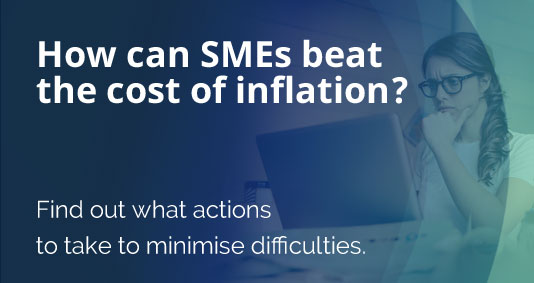
How can SMEs beat the cost of inflation?
Recent reports have shown that SMEs are still focusing their energy to continue their growth, but these efforts are being eclipsed by concerns over inflation.

Recent reports have shown that SMEs are still focusing their energy to continue their growth, but these efforts are being eclipsed by concerns over inflation.
The biggest concern of over three quarters of small business owners is inflation in relation to the cost of running their business as well as preventing their growth strategies. FSB’s Q4 Small Business Index found that “Spiraling energy costs are causing widespread difficulties, especially for micro-businesses of fewer than 10 employees, who face many of the same challenges as consumers when it comes to negotiating energy deals but without the same protections.”
SMEs should have a business plan in place with a cash flow strategy that they can refer to should their business need to make unexpected payments or should the business need to ready itself against inflation.
The cost of doing business is becoming more expensive and SMEs are reportedly spending more to continue trading. As the cost of living rises for both consumers and businesses, SMEs need to find alternative ways to balance profit margins that do not rely on raising prices over the level of inflation in order to make a profit.
Trade Finance can help offset and close potential payment gaps and assuage higher costs in import/export fees so that you continue to fulfil customer orders on time and free up cash to pay your expenses. Trade finance can also reduce risks regarding currency fluctuations which you may experience this year as inflation is currently affecting the global economy.
Use Invoice Finance to manage your cash flow, get better control over your working capital and recoup the cost of late payments. Late payment culture has a detrimental effect on an SME’s ability to grow and sustain the business. With Invoice Finance you can receive up to 95% of the value of an invoice, minus lender fees, in a matter of days.
There are three types of Invoice Finance: Invoice Discounting, Invoice Factoring and Selective Invoice Financing. For a business that is looking to mediate the impact of inflation, Selective Invoice Financing may be the best choice.
Selective Invoice Financing is a short-term flexible invoice finance option that has no contract tie-in and allows you to decide which invoices you want to fund. Fees are only applied to the invoices you choose to fund, making it the most cost-effective option.
Using up all of your savings to purchase large ticket items like vehicles, machinery and equipment outright is not often the best option. Using Asset Finance to spread the cost of large assets across small regular payments means that you can use the assets your business already owns as collateral to make additional purchases on items. Following this route will allow you to expand your business growth and increase the potential for trade.
A working capital loan is a short-term loan that can be used to help facilitate the day-to-day running of operations so that you can focus on business growth. Working Capital loans provide much-needed cash injections into your business and can be the finance option most suitable for keeping businesses sustained through tough market conditions such as these.
Our partner Finpoint supports SMEs in getting the right business finance. It is transparent about its fees and rates, and gives access to the UK’s largest panel of business lenders. Find out more